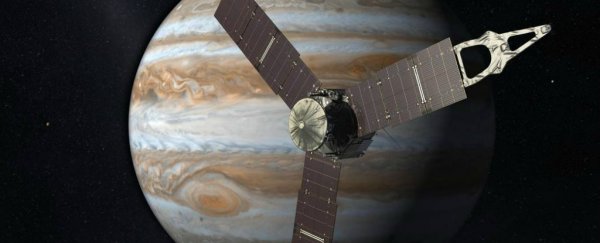On 4 July, NASA's basketball court-sized Juno spacecraft will finally arrive at Jupiter, completing its approximate 600 million-kilometre (372 million-mile) trip through the Solar System.
While there, Juno hopes to perform 37 close approaches, collecting valuable data for researchers back here on Earth. If all goes well, Juno will explore the gas giant closer than any other spacecraft in history, including 1974's Pioneer 11.
"At this time last year our New Horizons spacecraft was closing in for humanity's first close views of Pluto," said Juno's program executive Diane Brown. "Now, Juno is poised to go closer to Jupiter than any spacecraft ever before to unlock the mysteries of what lies within."
The mission will not be easy, though. To perform the necessary experiments, Juno will have to fly inside Jupiter's atmosphere, a place that's pretty intense.
Here, Juno will experience immense pressures from the planet's quick rotation – a day on Jupiter is only 10 hours long – which creates a powerful magnetic field, coupled with extremely high levels of radiation and atmospheric pressure. In fact, NASA says that Jupiter's radiation-filled environment is the harshest in the Solar System.
"Over the life of the mission, Juno will be exposed to the equivalent of over 100 million dental X-rays," said Juno's project manager Rick Nybakken.
"But, we are ready. We designed an orbit around Jupiter that minimises exposure to Jupiter's harsh radiation environment. This orbit allows us to survive long enough to obtain the tantalising science data that we have travelled so far to get."
The good news is Juno is armoured like a knight prepared for cosmic battle from its wires to its sensors. But the most important piece of protection is its 'titanium vault', which houses its central computer.
This titanium vault weighs roughly 181 kilograms (400 pounds) and will reduce the amount of radiation felt by the instruments inside by 800 times that of the surrounding environment. Even so, that amount of radiation will still take its toll, allowing for the craft to only operate for roughly 20 months before it gets overwhelmed.
"Over the course of the mission, the highest energy electrons will penetrate the vault, creating a spray of secondary photons and particles," said team leader Heidi Becker, who is responsible for monitoring radiation levels during the mission. "The constant bombardment will break the atomic bonds in Juno's electronics."
Originally launched on 5 August 2011, Juno is set to become the first spacecraft to ever pull off such a detailed mission to the gas giant - but the first craft to reach Jupiter was Pioneer 10 back in 1973, which provided the first close-up images of the planet.
Pioneer 10 was followed a year later by Pioneer 11, which flew within 34,000 kilometres (21,127 miles) of Jupiter's clouds. Juno, on the other hand, will fly only 4,667 kilometres (2,900 miles) above the clouds.
Juno's arrival at Jupiter couldn't come at a better time, either. Earlier this month, researchers working with the Very Large Array – a radio telescope in New Mexico – were able to examine what is behind Jupiter's famed clouds. Now, Juno has a chance to verify some of these findings up close.
Over the coming months, we should start to see the results of the mission pour in just like we did last year when New Horizons performed its Pluto flybys, capturing the world's imaginations in the process.
But, if you're still not pumped for the mission, check out NASA's trailer for it below!
